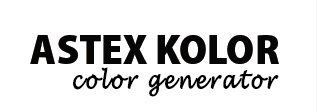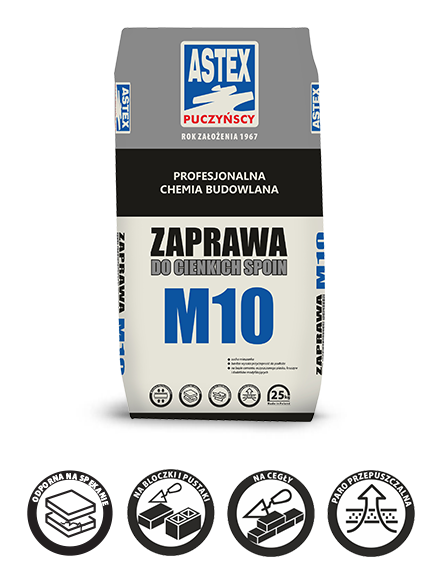Masonry mortar for thin joints M10
M10 thin mortar is intended for thin-layer masonry of external and internal walls, gluing and joining aerated concrete blocks, silicates, hollow bricks, ceramic materials, bricks and other similar materials.
- Strength class M10
- Available in white and gray
- High grip
- High durability
- Frost resistant
Calculate expenditure
Expenditure
3.0-4.0 kg / m² of wall with a wall thickness of 24 cm
Shell life
12 months from the date of production
Packaging
25 kg
Application
Thin mortar is intended for thin-layer masonry of external and internal walls, gluing and joining aerated concrete blocks, silicates, hollow bricks, ceramic materials, bricks and other such materials. It is used in small and multi-purpose construction, both for newly constructed buildings and those renovated. It can also be used for leveling surfaces (up to about 5 mm) thick.
Properties
Thin joint mortar is a ready, dry mix of the highest quality, based on cement, cleaned sand, aggregates and modifying additives. It is characterized by good plasticity and adhesion to various types of building materials, which makes it a product with a very versatile application and easy to process. With very high adhesion to the ground. Thin joint mortar is a frost and waterproof product. It is also characterized by high tightness. Thanks to its properties, a thin layer of 2-3 mm prevents the formation of thermal bridges in single and multi-layer walls. It also affects the faster pace of construction works.
Substrate preparation
The substrate should be dry, matured, stable, even and sound, i.e. strong enough, cleaned of layers that can weaken mortar adhesion (dust, dirt, lime, oils, fats, wax, residual oil and emulsion paint). Excessive absorbency of the substrate should be reduced by using UNI-ASTEX priming emulsion. If it is necessary to make a layer of plaster on solid substrates with a load capacity difficult to determine (e.g. dusty, difficult to clean), it is recommended to carry out an adhesion test consisting in applying a control layer and checking the connection after a minimum of 48 hours.
Mortar preparation
Preparation involves pouring mortar into a container with the right amount of water (5.5 - 6 liters per 25kg). Then mix the mass manually or mechanically using a low-speed drill with a stirrer (mixers) or cement mixer until a homogeneous mass without lumps is obtained. Leave for about 5-10 minutes and mix again. If necessary - add a small amount of water and mix again to obtain the right consistency. It is unacceptable to modify the mortar by adding other components of construction chemicals, e.g. sand, cement, as this may cause loss of mortar properties.
Application method
Mortar for thin joints is applied after preparing the substrate. It is unacceptable to apply too thick layer exceeding the standard values in construction once. After applying the mortar, proceed to the initial arrangement of cellular material by collecting excess mortar using a trowel. When the mortar dries thin joints inside the room, good ventilation must be provided. When working outside, protect the applied layer from direct sunlight (drying out too quickly, which may lead to cracking of the mortar), as well as protect the surface from direct rain. The air and surface temperature must be positive (above + 5 ° C). In addition to the recommendations provided, work should be carried out in accordance with building practice and health and safety rules. The manufacturer guarantees the quality of the product, but has no effect on the conditions and the way it is used. In case of doubt, contact the manufacturer's technical advisor on the phone number provided on the packaging.
Expenditure
On average, 3-4 kg is used per m² of 24 cm thick wall. In practice, the wear depends on the degree of thickness of the weld, as well as the dimensional accuracy of the joined elements.
Storage and transport
The products must be absolutely stored in undamaged packaging and dry rooms on pallets. Protect against moisture, moisture during storage and transport. The storage period of the product in conditions complying with the recommendations given is up to 12 months from the date of production placed on the packaging in digital print. The production date, which is placed on the packaging, is also the date of manufacture of the product. Any changes in the structure of the product or packaging that are visible without specialized tests, in particular discoloration or smudging of the packaging graphics, infringements of the continuity of the packaging, biological changes in the structure of the product, recognizable in particular as a consequence of moisture, may indicate poor storage or transport conditions and do not guarantee compliance declared product performance according to specifications.
Packaging
Paper bags 25 kg. Pallet: 54 bags, 25 kg each = 1350 kg.
Precautions
The product contains cement which, when mixed with water, gives an alkaline reaction. Take measures to prevent dusting or splashing with the mortar. Do not inhale, protect eyes and skin. In case of contamination: rinse eyes immediately with plenty of clean water and seek medical advice, wash skin with soap and water. Keep out of reach of children. If swallowed, seek medical advice immediately and show the container or label.
Temperature of performed work
Air temperature from + 5 ° C to +25 ° C. Substrate temperature from + 5 ° C to +25 ° C. Work in temperature between +5 ° C and +25 ° C. For a period of 7 days after the completion of works, the air temperature should not be below +5 ° C, and for the next 21 days should not fall below 0 ° C.
Do you have questions? Doubts? Ask an advisor Contact form












